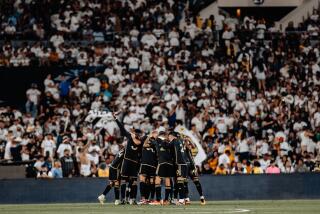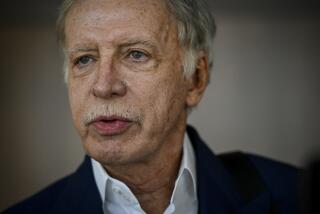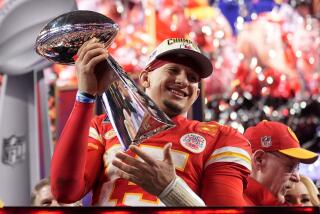The first Super Bowl, in L.A. in 1967, wasn’t even called the Super Bowl and gave little hint of game’s future impact
The impenetrable layer of fog that had blanketed parts of Los Angeles, choked freeways with accidents and closed L.A. International Airport for almost 13 hours finally gave way to the cloudless promise of a new day on that Sunday morning 49 years ago.
Tens of thousands of spectators streamed into the L.A. Memorial Coliseum for the inaugural AFL-NFL World Championship Game. They wore shirt sleeves and sport coats and ties as temperatures climbed into the low 70s. A shorter, unofficial name for the game had taken hold months earlier: the Super Bowl.
Red, white and blue bunting seemed to hang from every available surface. The grass looked particularly lush thanks to $3,000 of spray paint administered a day earlier. A group of fans carried a banner: “Go Chiefs, Scalp the Packers.”
See the most-read stories in Sports this hour>>
Ten astronauts joined the crowd. Same with celebrities such as Chuck Connors and Kirk Douglas. So did 770 credentialed media. They waited to see the result after months of wrangling behind closed doors, breathless pronouncements and last-minute planning for the rival leagues that were newly minted partners to finally collide on the field.
“The fans are going to come out thinking they will see a curiosity piece, something really different,” one reporter in town to cover the game said at the time. “I think they will be disappointed.”
Eleven television cameras scattered around the stadium prepared to broadcast the game on CBS and NBC to millions of viewers across the country. They included President Lyndon Johnson, finishing a lunch of hamburgers and fruit at Camp David in Maryland.
Journalists across the country were still analyzing the president’s sober assessment of the war in Vietnam during his State of the Union address a few days earlier.
FULL COVERAGE: The Road to Super Bowl 50
“I wish I could report to you that the conflict is almost over,” Johnson told Congress. “This I cannot do. We face more cost, more loss, and more agony.”
Uncertainty filled L.A.’s thick Sunday newspapers. Eight U.S. soldiers had died when their CH-47 Chinook helicopter was shot down south of Saigon. Tension simmered between Syria and Israel. U.S. B-52 bombers had been spotted at a base near Bangkok. Mao Tse-tung’s Red Guards marched through China.
A more immediate concern lurked in the midst of advertisements for six-packs of 102 draft beer, computerized matchmaking services and a 23-inch Packard Bell color television with “Hi Fi sound” priced at $569.75. The set wouldn’t be of much use because the Super Bowl broadcast would be blacked out within a 75-mile radius of L.A. The game wasn’t sold out. Not even close. But the NFL’s bottom-line decision provoked weeks of angry denouncements from local politicians, a federal lawsuit and, amid the outcry, a few lines buried in miles of classifieds.
Alongside brief notices hawking devices to bug entire rooms or secret methods to win at dice, an entrepreneur offered plans to beat the blackout. Send $2 to a post office box in Fort Worth, Texas, and you’d receive plans to construct a “special antenna from household items” capable of picking up the broadcast from San Diego. The advertisement promised a refund if the contraption didn’t work.
Otherwise, L.A. viewers were left with a tape-delayed broadcast of “Meet the Press” discussing the bombing of North Vietnam or a murder mystery starring Maureen O’Sullivan when the Chiefs and Packers made history at 1 p.m. on Jan. 15, 1967.
::
Six months earlier, the upstart American Football League and old-guard NFL announced a merger after years of bitter competition. They agreed to meet in a championship game at a site to be decided by a committee of three owners from each league.
Cleveland Browns owner Art Modell quickly endorsed the idea of playing the game — some dubbed it the World Series of Football — at the Coliseum or Rose Bowl. L.A. had the temperate climate and population base the leagues wanted.
The L.A. City Council took up the idea in late September and unanimously adopted a resolution urging the Coliseum’s selection. The document noted that 67,378 theater-style seats had been recently installed at the stadium and touted L.A. as the “sports capital of the world.”
Colleges and conferences pushed back against the mere suggestion that the Rose Bowl would associate with professionals.
“There is no question educators would look askance if the pros came in,” Big Ten Commissioner Bill Reed said at the time.
Anaheim Stadium tried to get involved, but the venue’s relativity small size — 55,000 seats — didn’t help.
“I’m going to keep after them,” Tom Liegler, the stadium’s manager, said at the time.
By mid-November, NFL commissioner Pete Rozelle — born in South Gate, raised in Lynwood, formerly a public relations man and then general manager for the Rams — identified the Coliseum, along with Miami’s Orange Bowl, Houston’s Astrodome and the Sugar Bowl in New Orleans, as potential sites.
The decision leaked Nov. 17 in The Times in a four-paragraph story with no source and no byline. When Rozelle formally announced the site a couple of weeks later in New York, the commissioner identified the “ideal weather” in L.A. and the Coliseum’s ability to seat 93,000 people. The deal wasn’t bad for the stadium: concession revenue plus 10% of the gate up to $50,000.
Red Smith, for one, warned against the game’s hype.
“This is a game and only a game,” the legendary New York Times sports columnist wrote. “It can be played by 90 pound boys and 300 pound brutes with half formed minds. It will prove nothing except that professional football is a more lucrative occupation in 1967 than it was in 1941.”
But even as officials from the Coliseum and NFL predicted that the game would be a million-dollar sellout, the league still planned to black out the game in the L.A. area. The City Council eschewed the usual bureaucratic niceties and adopted a resolution in late December that called the maneuver “absolutely pointless” and an “outright snub” to L.A. residents. A stockbroker named Alan Minter sued the NFL in U.S. District Court in L.A. in a futile attempt to prevent the blackout.
“The game,” one columnist wrote, “has not yet caught on with the local populace.”
Another columnist compared Rozelle, who felt that caving to demands to end the blackout would set a fateful precedent, to Italian dictator Benito Mussolini.
A local radio station told listeners how to fashion an antenna from a broomstick, five coat hangers and wire to snatch the San Diego broadcast. Arrangements were made so patients at five L.A.-area Veterans Administration hospitals, many wounded in Vietnam, could watch on a closed-circuit feed.
Hotels around Southern California offered packages to escape L.A. to watch the game. At the Islandia Hotel in San Diego, for example, $27.50 got you a room, a no-host cocktail party and the choice to follow the Chiefs and Packers on either black and white or color televisions.
L.A. Mayor Sam Yorty, featured on Time magazine’s cover a few months earlier, didn’t hold back.
“In a way I am sorry I worked so hard to bring the Super Bowl game to Los Angeles,” he said at the time, “because more people here would see it if they were somewhere else.”
::
Thousands of seats were vacant inside the Coliseum. The $6 seats in the peristyle end were virtually deserted. Chiefs owner Lamar Hunt noticed the vast section’s distance from the playing field.
“That’s the best deal,” Hunt said. “You buy one of those and bring along a Sony TV set.”
Someone reminded him about the blackout.
“Yes,” he said. “I know about the blackout. But those seats are beyond the 75-mile limit.”
The 63,036 spectators in the stands scooped up $1 programs. They saw the six referees wearing black-and-white uniforms created for the game. They weren’t close enough to notice the Chiefs used the AFL’s standard Spalding J5V football when on offense while the Packers carried the NFL’s Wilson “Duke” model.
“The setup was an insult to the intelligence of the Los Angeles public,” one columnist wrote, “and a good part of the public simply refused to be insulted.”
Those who weren’t too insulted to attend witnessed a 20-minute halftime show: “Super sights and sounds.” That meant 10,000 helium-filled balloons and hundreds of pigeons. Jazz trumpeter Al Hirt. Marching bands from Grambling State University and the University of Arizona, playing “The Sound of Music.” Anaheim High School’s drill team. The Ramettes. Even two men from Bell Aerosystems who strapped jetpacks to their backs and shot 100 feet above the field.
Halftime during the NFL’s Pro Bowl at the Coliseum the following week would include a skit reenacting a cavalry charge and Indian massacre.
But the long-awaited clash between the AFL and NFL sputtered into a 35-10 blowout by the Packers. Each of the winning players received $15,000; the Chiefs got $8,500 apiece. The sterling silver trophy designed by Tiffany’s — a football on a three-sided base with the logos for both leagues — belonged to Green Bay.
“I think,” Rozelle said, “it was a tremendous show.”
The fog rolled back in that night. Flights were canceled. Beverly Hills police busted an art theft ring whose heists had included a centuries-old portrait of a Manchurian princess. The Rolling Stones performed a controversial censored version of “Let’s Spend the Night Together” on “The Ed Sullivan Show.” And those still awake at midnight in L.A. could finally watch the tape-delayed Super Bowl on local television and witness the spectacle that was just beginning.
Follow Nathan Fenno on Twitter @nathanfenno
Sources for this story include archives of the Los Angeles Times, Milwaukee Journal, Long Beach Independent, Associated Press, United Press International, the Lyndon Baines Johnson Presidential Library, Pro Football Hall of Fame and L.A. City Council in addition to “When it was just a game.”
More to Read
Go beyond the scoreboard
Get the latest on L.A.'s teams in the daily Sports Report newsletter.
You may occasionally receive promotional content from the Los Angeles Times.











